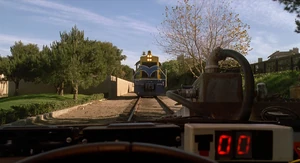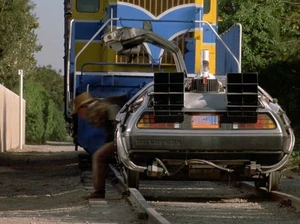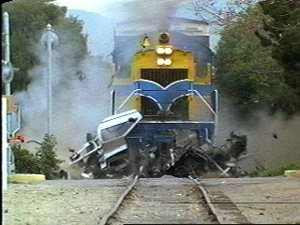Cyrus Ramsey (talk | contribs) No edit summary |
(→Behind the scenes: a little finetuning) |
||
| Line 14: | Line 14: | ||
==Behind the scenes== |
==Behind the scenes== |
||
* The name Alco derives from the acronym ALCO, which stands for American Locomotive Company. This company was formed in 1901 from a merger of several smaller locomotive builders. They were the second largest builder of steam locomotives in the United States, but gradually switched to production of diesel locomotives from the 1920s through the 1940s. They went out of business in 1969. |
* The name Alco derives from the acronym ALCO, which stands for American Locomotive Company. This company was formed in 1901 from a merger of several smaller locomotive builders. They were the second largest builder of steam locomotives in the United States, but gradually switched to production of diesel locomotives from the 1920s through the 1940s. They went out of business in 1969. |
||
| − | * The Alco |
+ | * The Alco S6 was a diesel-electric switching locomotive, an updated version of the earlier S-5 model. A total of 126 were built at Alco's Schenectady, New York plant between 1955 and 1960. They were powered by a four-stroke diesel engine that gave them a maximum output of 900 horsepower and a top speed of 60 m.p.h. The S6 was 45 feet long and weighed about 100 tons. As of 2020, most S6s have been retired, but a handful remain in service on small regional railroads. |
| − | * In the quote above, it's almost certain that Marty overestimated the train's speed. Although the |
+ | * In the quote above, it's almost certain that Marty overestimated the train's speed. Although the S6 was capable of 60 m.p.h., it would not have been going that fast through a residential area. The speed limit for freight trains in that area would most likely have been either 10 or 25 m.p.h. |
* The Alco S6 is never referred to by name on-screen, or in [[Craig Shaw Gardner]]'s novelization (see Quote above) where it is referred to simply as "a diesel engine". Its name is confirmed only in ''Back to the Future: The Game - Episode 1: It's About Time''. |
* The Alco S6 is never referred to by name on-screen, or in [[Craig Shaw Gardner]]'s novelization (see Quote above) where it is referred to simply as "a diesel engine". Its name is confirmed only in ''Back to the Future: The Game - Episode 1: It's About Time''. |
||
* On Wikipedia, the locomotive is called ALCO S-6 (exact page name). |
* On Wikipedia, the locomotive is called ALCO S-6 (exact page name). |
||
Revision as of 11:51, 23 May 2020

The S6 locomotive approaching the DeLorean time machine from Marty's point of view.

The locomotive just before collision with the DeLorean. Marty can be seen escaping through the driver's door.

The DeLorean is totaled in the collision.
- " Marty heard a low, moaning sound — not an old-fashioned train whistle, but a modern diesel horn. / Maybe, he realized, the crossing gates wouldn't close for something as small as a DeLorean. He looked down the tracks as the car swung around a narrow curve. There, directly ahead of him, was a diesel engine headed his way. With the train wheels on the DeLorean locked onto the tracks, there was no way he could turn to avoid a head-on collision! / The DeLorean had almost slowed to a complete stop by now, but the diesel showed no sign of changing speed. Marty threw open the gullwing door. He jumped and rolled clear. / He stopped himself, and looked up to see the diesel engine smash into the DeLorean at sixty miles an hour or better. / The DeLorean was totaled. Bits and pieces of the time machine were sent flying everywhere. Marty ducked and covered his head with his arms to protect himself from the flying debris. / The diesel didn't even stop. It just kept on going as if the driver hadn't even noticed the DeLorean was there. / Marty uncovered his head and stood as the train sped away. / "Oh, God, no!" Marty cried. "No!" / There were twisted bits of the DeLorean everywhere. There was no way to get Doc now — not any more. Marty fell to his knees. After all that had happened, this was just too much to take. / "Well, Doc," he said, once he'd gotten control of himself. "It's destroyed. Just like you wanted." "
- —From Back to the Future Part III by Craig Shaw Gardner (quote, pages 202 and 203)
An Alco S6 locomotive ran on the railroad line that passed the Hilldale development in 1985. It was painted in a Ventura County Railway yellow and blue scheme.
History
On the morning of Sunday October 27, 1985, the Alco S6 encountered the DeLorean time machine on the tracks. The engineer sounded the locomotive's horn seconds before collision.
Moments after Marty McFly escaped from the vehicle, the locomotive smashed into the DeLorean, effectively destroying it. The locomotive continued past the railroad crossing and over "Eastwood Ravine".
Behind the scenes
- The name Alco derives from the acronym ALCO, which stands for American Locomotive Company. This company was formed in 1901 from a merger of several smaller locomotive builders. They were the second largest builder of steam locomotives in the United States, but gradually switched to production of diesel locomotives from the 1920s through the 1940s. They went out of business in 1969.
- The Alco S6 was a diesel-electric switching locomotive, an updated version of the earlier S-5 model. A total of 126 were built at Alco's Schenectady, New York plant between 1955 and 1960. They were powered by a four-stroke diesel engine that gave them a maximum output of 900 horsepower and a top speed of 60 m.p.h. The S6 was 45 feet long and weighed about 100 tons. As of 2020, most S6s have been retired, but a handful remain in service on small regional railroads.
- In the quote above, it's almost certain that Marty overestimated the train's speed. Although the S6 was capable of 60 m.p.h., it would not have been going that fast through a residential area. The speed limit for freight trains in that area would most likely have been either 10 or 25 m.p.h.
- The Alco S6 is never referred to by name on-screen, or in Craig Shaw Gardner's novelization (see Quote above) where it is referred to simply as "a diesel engine". Its name is confirmed only in Back to the Future: The Game - Episode 1: It's About Time.
- On Wikipedia, the locomotive is called ALCO S-6 (exact page name).
Appearances
- Back to the Future Part III
- Back to the Future: The Game
- Back to the Future: The Game - Episode 1: It's About Time (Mentioned as the train that destroyed the original Delorean.)
